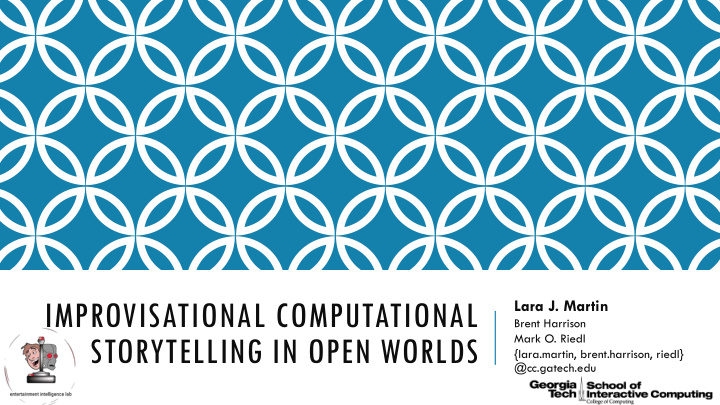



IMPROVISATIONAL COMPUTATIONAL Lara J. Martin Brent Harrison STORYTELLING IN OPEN WORLDS Mark O. Riedl {lara.martin, brent.harrison, riedl} @cc.gatech.edu
IMPROVISATIONAL 2
3
WHAT THE HECK DID WE JUST SEE? The American version of the show Whose Line Is it Anyway? Season 3, Episode 8 Sure, but… They’re building a story. They’re reinterpreting the surgery theme by adding a spy and a Film Noir feel. They’re building up and playing off of our and each others’ expectations. But also, they’re making (occasionally humorous) responses that break our expectations. 4
I GIVE UP. HOW DO THEY DO IT? Script Script Script Deviation Improv Script Script Simple, right? Magerko B, Manzoul W, Riedl M, et al (2009) An Empirical Study of Cognition and Theatrical Improvisation. In: Proc. Seventh ACM Conf. Creat. Cogn. ACM, pp 117 – 126 5
HUMANS CAN DO IT. SO WHY CAN’T COMPUTERS? It takes a lot of expertise. Computational systems tend to be experts in a single area. The response needs to be quick (real-time). 6
OPEN WORLDS 7
OUR DEFINITION OF AN “OPEN WORLD” All possible thoughts a Possible actions human can think that a character of and express can perform through language 8
OKAY, SO IT’S HARD. BUT AT LEAST WE’RE NOT STARTING FROM SCRATCH...? 9
COMPUTATIONAL STORYTELLING 10
INTERACTIVE NARRATIVE + Computational + Computational + Storytelling + Storytelling - Improvisational + Improvisational - Open World - Open World 11
NOW LET’S MAKE IT AN OPEN WORLD! 12
IMPROVISATIONAL STORYTELLING Improv Theater Interactive Narrative 13
“Interactive Script” 14
WHAT DID WE GET OURSELVES INTO? ! 15
WE HAVE A PLAN. 16
HOW DO WE HANDLE HUMANS? 1. We have to assume that the user has a set of scripts, like improv actors. 2. Depending on what the human does, the agent chooses the appropriate actions based off of 3 strategies: Constituent Consistent Exceptional 17
THE SETUP $ 18
HOW IT SHOULD END $ 19
CONSTITUENT (SAME) $ 20
CONSISTENT $ 21
EXCEPTIONAL $ 22
GRAPH-BASED REPRESENTATION 23
PLOT GRAPH (SCRIPT) LEARNING Li B, Lee-Urban S, Johnston G, Riedl MO (2013) Story Generation with Crowdsourced Plot Graphs. In: Proc. Twenty-Seventh AAAI Conf. Artif. Intell. pp 598 – 604 24
OUR GENERAL FRAMEWORK Agent Response $ History Constituent $ $ Scripts World Knowledge Consistent $ Exceptional User Turn Representation 25
CONSTITUENT * John arrives at the bank John pulls out his gun Sally gives Sally gives “Sally throws John the bag of coins.” John shoots John the John the Sally money money “John gets back on his horse, Virginia.” Sally John John sends for mounts his mounts his help horse horse The sheriff John escapes arrests John *Not a real plot graph. 26
CONSISTENT John arrives at the bank John pulls out his gun “Sally runs into the bank.” Sally gives John shoots John the Sally money $ Sally John sends for mounts his help “John locks the bank.” horse The sheriff John escapes arrests John 27
EXCEPTIONAL John arrives at the bank Goes to the Hospital John pulls out his gun “Sally shoots John before he can escape.” Sally gives John shoots John the Sally $ money Sally John sends for “John calls for an ambulance.” mounts his help horse “The ambulance arrives just in time for John to survive.” The sheriff John escapes arrests John 28
GRAPH-BASED REPRESENTATION Pros Cons Clear story flow Crowdsourced separately for each genre Can have multiple scripts Script might not be ideal Can be acquired from just a (matching user, boring, etc.) few special stories Awkward transitioning between scripts Reliant on sentential NLP 29
NEURAL NET REPRESENTATION 30
OUR FRAMEWORK (REVISITED) Agent Response Sample $ History NEURAL NET Constituent $ Decision-Maker $ Scripts World Knowledge Consistent $ Exceptional User Turn Representation 31
NEURAL NET REPRESENTATION Pros Cons Self- learning internal “memory” Need a lot of stories Transitions easily between Don’t know what genres goal/objective function to optimize for (surprisal, Can use any stories consistency, etc.) Hard to see why an agent makes certain decisions 32
WHY ARE WE DOING THIS? It’s fun! Serious games for training (forensics, strategists) Problem-based inquiry educational games (open-ended problem- solving) Integration into conversational agents to appear more human A glimpse into cognitive processes of human improv 33
DISCUSSION This is not a solved problem. Are we covering all possible scenarios for how a story can unfold? What kind of data should we be training on? Can it scale? What does it mean for a story to be considered “good” or “entertaining”? How “creative” can we be before things get weird? 34
Thank you! Lara J. Martin ljmartin@gatech.edu laramartin.net Icons taken from flaticon.com and adapted for this presentation. “Whose Line” video cut from https://youtu.be/XmnZ9HZTHjw 35
Recommend
More recommend